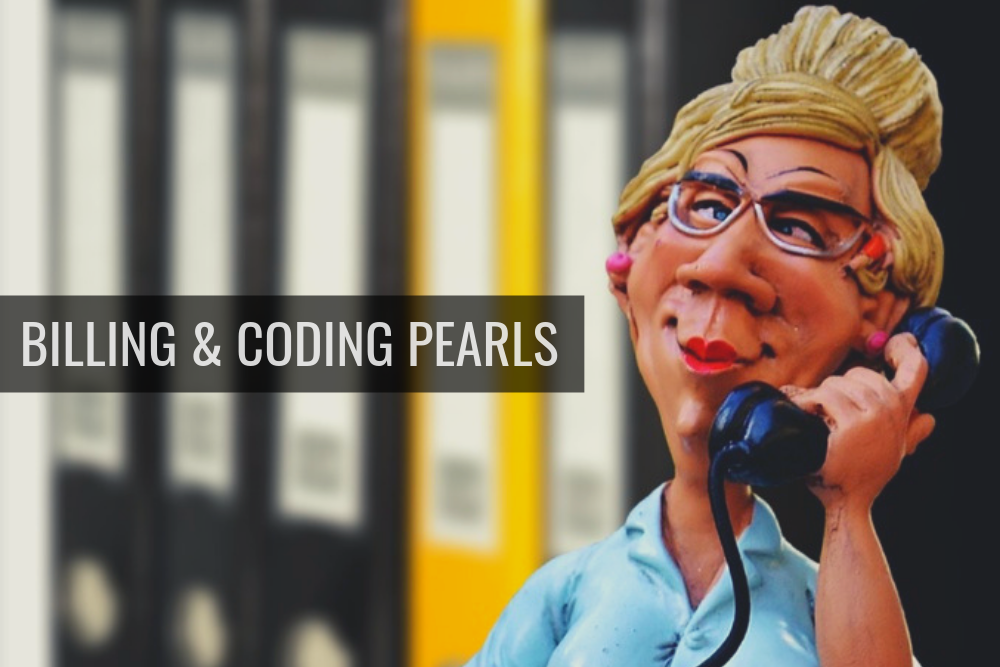Most think the full patient story is in the medical records. This is partially true, but a large part of the patient treatment story is told by the CPT codes billed and the modifiers added to those CPT codes. There are hundreds of modifiers to choose from and choose wisely because the modifiers added to a code could result in a denied or unpaid claim.
Modifiers May Be Used To:
- Identify a related or unrelated procedure when patient is in a global period.
- Separate and office visit charge from other services provided on the same date.
- Alert payers to an increased or decreased service.
- Designate a body part treated.
And so much more!
Example charges with modifier usage and description:
Example A:
99214-24-25
11102-79
17000-59-79
17003-79
Sample Scenario:
Patient is seen for and E/M within a global period (-24) but also had significant, separately identifiable evaluation on the same date as another procedure or service (-25). The patient is in a global period of previously provided service. As a result, the surgical services will require the (-79) modifier to alert the payer that they are UNRELATED to the previously provided services. The surgical services provided are codes 11102- a biopsy, no additional modifier required, 17000 (-59) destruction, first lesion, and 17003 destruction 2-14 lesions. Modifier (-59) is used to alert the payer that the services are not related to the biopsy also performed on the same date. The 17000 code is separated from the biopsy charge and is the primary code for the 17003 CPT code so no additional modifier is needed for the charges to process.
Example B:
99213-25
17272
17262
17110-59
11102-56
Sample Scenario:
Patient is seen for and E/M and receives surgical procedures at the same visit on the same date of service. The E/M was a significant, separately identifiable evaluation as shown by a different diagnosis than what is billed on the procedures and a (-25) modifier is added to the E/M code. Procedure code 17272 (scalp, necks, hands, feet), destruction-malignant lesion-lesion diameter 1.1 to 2.0 cm, procedure code 17262 (trunk, arms or legs), destruction-malignant lesion-lesion diameter 1.1 to 2.0 cm-, procedure code 17110, destruction up to 14 lesions requires the (-59) modifier to alert the payer that the destruction is separate from the 17272 & 17262 which are also part of the Destruction CPT family. Lastly, code 11102, a biopsy, also has a (-59) modifier to alert the payer that the service does not bundle with the other services provided and the diagnosis should support.
These two-digit numeric and alphanumeric codes provide payers the additional details of the service(s) provided and assist in proper payment processing. Some of the most used modifiers in Dermatology are listed below:
- Unusual Procedural Services (-22)
- Unrelated E&M Service, same physician, during post-operative period (-24)
- Significant, Separately Identifiable E&M service the same day as other procedure or service (-25)
- Services provided Bilaterally (-50)
- Discontinued Procedure (-53)
- Distinct Procedural Service (-59)
- Repeat procedure performed, different physician (-77)
- Return to the operating Room for a related procedure (-78)
- Unrelated procedure/service by same physician during post-operative period (-79)
- The side of the body treated (-LT, RT)
To further understand modifiers and their usage, there are 2 levels of modifiers.
- Level 1 modifiers-modifiers appended to CPT
- Level 2 modifiers-modifiers appended to HCPC’s
They are broken down further into categories. See below:
A. Pricing Modifiers– assist with determining the charge/fee for a service
Examples: (-26) – Professional Component (-TC) – Technical Component
B. Statistical/Informational Modifiers-used for documentation purposes and can affect payment processing.
Examples: (-Q6)-Services furnished by a locum tenens physician (-QW)– CLIA Waived test
It is important to understand the modifiers description(s). If applicable with the services provided, can be added to your code for services provided.
For a full guide to modifiers and their descriptions go to:
https://www.sccma-mcms.org/portals/19/assets/docs/modifier-reference-guide.pdf
Save this guide as a point of reference to correctly add those modifiers to the services provided as needed.
Modifier Tips to Remember:
Modifiers -24 & -25 can only be added to an E/M CPT code.
Modifiers -24, -25, -76 & -79 pertain to charges within a global period.
Modifier -GA is required on a charge when billed as this alerts the payer that the patient has signed and ABN. In the event the services are not covered, the patient is responsible for the contracted rate of that charge.
Do not miss use modifier -59 as it is a widely reviewed modifier that has often been known to be used in incorrect instances. Be sure to use it only as needed and in the correct circumstances. Should there be any question there multiple resources to reach out to for information to include:
- AAPC – American Academy of Professional Coders: https://www.aapc.com/medical-billing/
- AAD – American Academy of Dermatology: https://www.aad.org/
- Inga Ellzey: http://dermatologybilling.com/ or their coding assistant site – https://dermcoder.com/
Reminder! Make sure the modifiers selected are correct and tell the story reflected in the medical record and get those services $PAID$!
Did you enjoy this post? Find more on Billing & Coding here.

